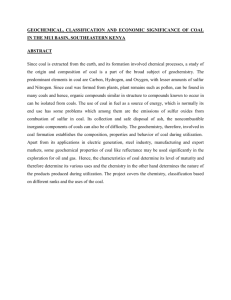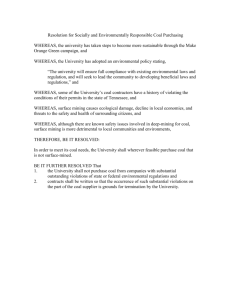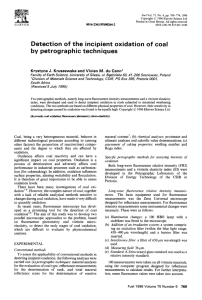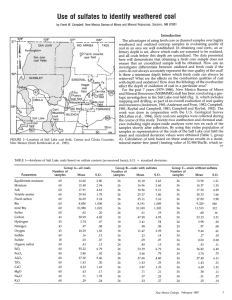The Geology of Coal
advertisement
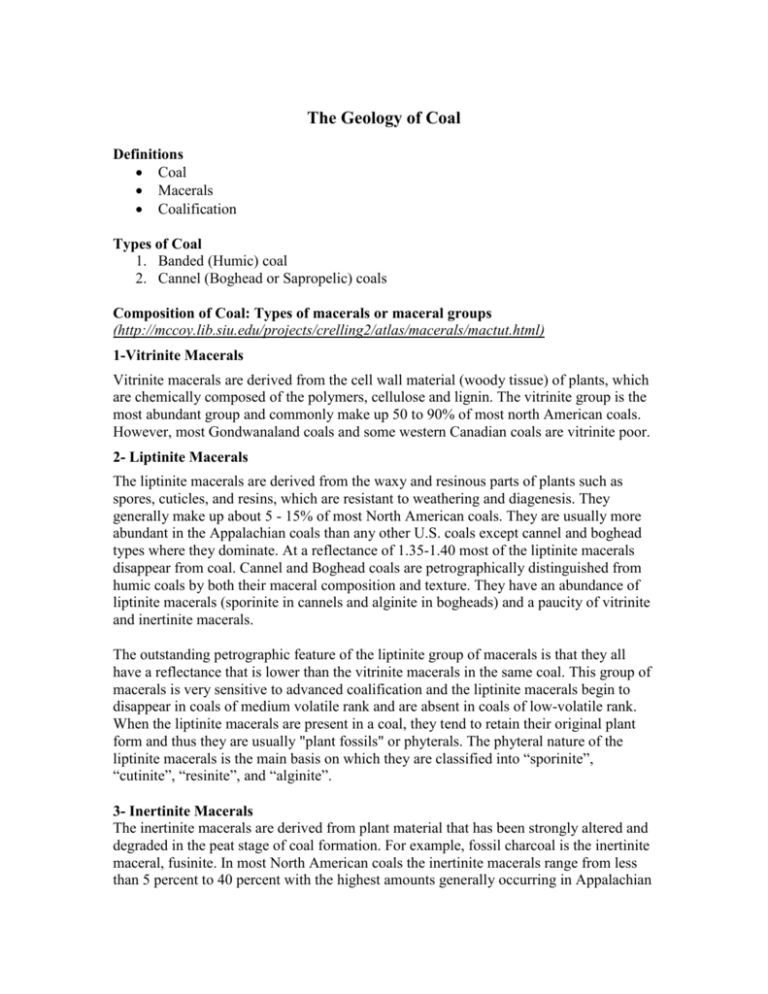
The Geology of Coal Definitions Coal Macerals Coalification Types of Coal 1. Banded (Humic) coal 2. Cannel (Boghead or Sapropelic) coals Composition of Coal: Types of macerals or maceral groups (http://mccoy.lib.siu.edu/projects/crelling2/atlas/macerals/mactut.html) 1-Vitrinite Macerals Vitrinite macerals are derived from the cell wall material (woody tissue) of plants, which are chemically composed of the polymers, cellulose and lignin. The vitrinite group is the most abundant group and commonly make up 50 to 90% of most north American coals. However, most Gondwanaland coals and some western Canadian coals are vitrinite poor. 2- Liptinite Macerals The liptinite macerals are derived from the waxy and resinous parts of plants such as spores, cuticles, and resins, which are resistant to weathering and diagenesis. They generally make up about 5 - 15% of most North American coals. They are usually more abundant in the Appalachian coals than any other U.S. coals except cannel and boghead types where they dominate. At a reflectance of 1.35-1.40 most of the liptinite macerals disappear from coal. Cannel and Boghead coals are petrographically distinguished from humic coals by both their maceral composition and texture. They have an abundance of liptinite macerals (sporinite in cannels and alginite in bogheads) and a paucity of vitrinite and inertinite macerals. The outstanding petrographic feature of the liptinite group of macerals is that they all have a reflectance that is lower than the vitrinite macerals in the same coal. This group of macerals is very sensitive to advanced coalification and the liptinite macerals begin to disappear in coals of medium volatile rank and are absent in coals of low-volatile rank. When the liptinite macerals are present in a coal, they tend to retain their original plant form and thus they are usually "plant fossils" or phyterals. The phyteral nature of the liptinite macerals is the main basis on which they are classified into “sporinite”, “cutinite”, “resinite”, and “alginite”. 3- Inertinite Macerals The inertinite macerals are derived from plant material that has been strongly altered and degraded in the peat stage of coal formation. For example, fossil charcoal is the inertinite maceral, fusinite. In most North American coals the inertinite macerals range from less than 5 percent to 40 percent with the highest amounts generally occurring in Appalachian coals. The inertinite macerals have the highest reflectance of all the macerals and are distinguished by their relative reflectances and structures. They include such types as “fusinite”, “semifusinite”, “macrinite”, “micrinite”, and “sclerotinite”. Coal Rank: Is a measure of the total amount (%) of carbon in coal (measured on a dry, mineral matter free basis). Four types according to rank: Lignite sub-bituminous bituminous anthracite. Increased rank is accompanied by an increase in its calorific value, % C, and vitrinite reflectance. It is also accompanied by a decrease in volatiles and moisture, as well as H. Coal grade: Is a measure of the amount of “undesirable” mineral matter in coal. This is often expressed as the amount of “ash” (non-combustible inorganic residue left behind after coal is burnt). World Distribution and Production Coalification: Terrestrial accumulation Burial Peat Diagenesis: biochemical followed by geochemical changes that increase the coal rank (C/H ratio). Optimum conditions: Swamps and deltas straddling continental margins with detrital continental sediment buildup, repeated transgressions and regressions producing cyclothems (cyclic sedimentary cycles containing limestone, shale, sandstone, coal). Major coal deposits are all post-Silurian (mostly Carboniferous or younger). Coal mining: Ratio of thickness of the overburden to that of the coal bed has to be less than 20:1 to make this viable. Open pit mining: Strip mining in flat areas vs. Contour mining on hilly terrain. Underground mining: Room and pillar mining (40 – 60% recovery) vs. low-angle mining (100% recovery). By-products of coal mining: Ganister: pure silica Seat Earth or fireclay: underclay Clay ironstones: rarely used.


